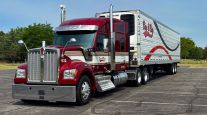Refrigerated Carriers Finding Value With Electric-Powered Reefer Units
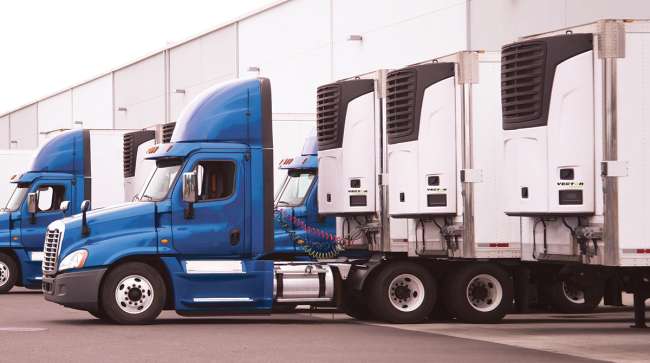
[Stay on top of transportation news: Get TTNews in your inbox.]
The use of electric power to refrigerate trailers is expected to surge in the coming years, according to some manufacturers and fleet operators.
Government regulations to reduce fossil fuel emissions are a major force driving fleet adoption of electric trailer refrigeration units, also known as eTRUs, combined with the trucking industry’s drive to lower operating costs and reduce equipment maintenance demands.
“There is a strong movement, in general, away from fossil fuel in the transportation and logistics industry to all electric or hybrid electric systems,” said Ian Fox, product manager for refrigerated vans at trailer manufacturer Wabash National Corp. “Electric-powered refrigeration systems are a part of that movement. Running a reefer unit on electricity is significantly cheaper than running on diesel fuel.”
KeHE Distributors started an effort to electrify “as many distribution centers as possible about two years ago,” said Tom Harden, senior manager of fleet assets for the organic and specialty foods distributor, which has 13 distribution centers and three additional locations where it keeps trailers.
The company, headquartered in Naperville, Ill., currently operates about 150 eTRUs. Harden said electric units are less expensive to operate than diesel-fueled units, though he pointed out that savings “vary across the country.”
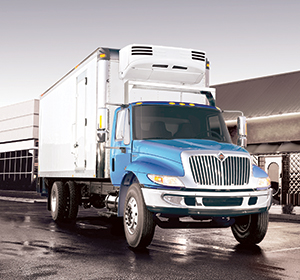
An International reefer. (Navistar International Corp.)
He cited an average kilowatt-per-hour cost in Stockton, Calif., of 11 to 12 cents. “But that same kilowatt hour in Georgia is going to be around 39 cents,” Harden said.
Savings from reduced use of diesel fuel likewise differ according to local or regional variations in prices, said Harden, who added that diesel prices are higher in California than Georgia.
Gordon Food Service, which ranks No. 14 on the Transport Topics Top 100 list of the largest private carriers in North America, operates 3,200 temperature-controlled trailers. Its trailers in the U.S. are equipped with diesel-fueled TRUs “for now,” said Jason Derby, Gordon Food Service’s fleet manager for North America.
In Canada, however, the company uses diesel-electric hybrids — Carrier Vector 8600MT and 8611MT units.
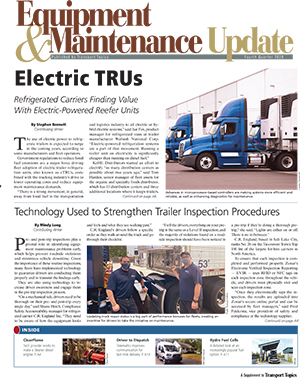
►Refrigerated carriers finding value with electric-powered reefer units
►Technology used to strengthen truck and trailer inspection procedures
►Technology provider hopes to strike balance on diesel engine
►Telematics strengthens communication between delivery driver and dispatch
►Baxter: Considerations for hydrogen-electric trucks
Derby likened the work of the hybrids to lighting a two-story house.
“You don’t need to light the entire house,” he said. “With an electric unit, you run only what you need, not the entire unit. The unit will give you electric heat without running the compressor. Individual fans and the electric scroll compressor can be cycled on/off as needed.”
The Road to Electrification
Wider use of eTRUs depends in some measure on increased use of electric- powered trucks, some said, as both require electrical infrastructure that, in many cases, needs to be built or upgraded.
“Certainly, there’s a very important crossover” between electrifying the Class 8 tractor market, and growing the use of plug-in TRUs and, “ultimately, the fully electrified eTRUs,” said Simon Horton, senior project manager for transportation for Southern California Edison, an electric supply company. “There’s definitely a synergy between the two electrification efforts.”
Horton noted, “We’ve got several [Freightliner] eCascadias operating in our service territory,” and several Volvo electric Class 8 tractors.
“Electric Class 8 trucks are daily doing drayage runs from the Port of Long Beach as well as intermodal runs,” he added.
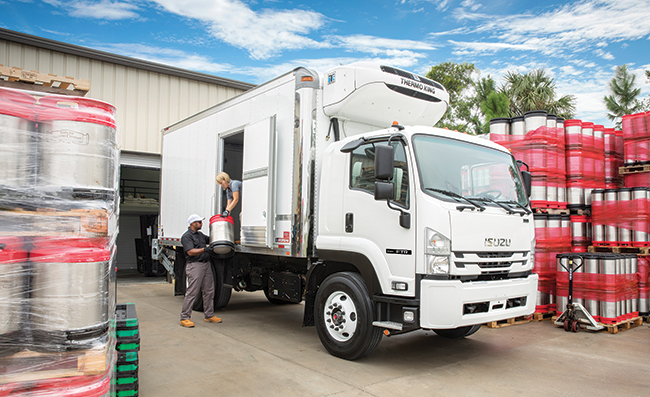
An Isuzu reefer. (Isuzu)
Many industry suppliers expect the electrification trend to accelerate in the years ahead.
“Everyone’s moving in that direction; it’s just a matter of maturity, cost of ownership and a lot of other obstacles,” said Paul Kroes, market insights leader at Thermo King Americas.
In the meantime, Kroes said, “There is a fairly good business case to suggest eTRUs will be pulled by combustion engine chassis, simply because there are benefits to having eTRUs regardless of what’s actually pulling them.”
Kroes estimated that “full adoption” of electric refrigeration units could be accomplished by the next decade. Mainstreaming of electric Class 8 tractors will happen first, Kroes predicted, “by 2025-2026, perhaps.”
Charging the units quickly and efficiently, wherever they are — fleet yards, distribution centers, truck stops — requires widespread infrastructure.
“The lead time to develop that infrastructure is quite long,” Kroes said, adding that bringing cost of ownership into parity with diesel units is a goal to be reached.
As systems go more electric, diagnosing them becomes more complicated, Kroes noted.

Kroes
“Technicians are usually more adept — or at least used to — diagnosing a diesel-fueled system,” he said. “Once you go to electric, the requirements for external diagnostic equipment, procedures, data downloads from the unit to figure out what’s gone wrong — that burden increases, or else it’s very difficult to figure out what needs to be fixed.”
While diagnostic software helps technicians make decisions during preventive and annual maintenance inspections, “The downside is the more sensors you attach to equipment, the higher your probability for false positives,” said Fox, of Wabash National.
The latest generation of refrigeration units have a suite of sensor and telematics packages that can help show early indication of issues, he said.
“If you notice the gallon-per-hour fuel usage on a trailer is higher or engine hours are substantially higher for a certain unit,” Fox explained, “it is worthwhile to check the reefer unit for any recent fault codes and perform a good overall inspection of the trailer structure to ensure everything is in good working order.”
Advances in microprocessor-based controllers are making systems more efficient and reliable, as well as enhancing diagnostics for maintenance, said Bill Maddox, a senior product manager at Carrier Transicold.
Operating software in controllers, such as Carrier Transicold’s APX control system, records data about system operations. Maddox noted that it can speed up the process of diagnosing problems and can often lead a technician directly to the point of trouble.
He said telematics systems in the refrigeration units are designed to further enhance maintenance and monitoring. Carrier Transicold’s eSolutions telematics system “can give fleets a bird’s-eye view of all of their refrigerated assets,” monitoring temperatures, location and overall TRU performance. Centralized monitoring via telematics can help build a comprehensive record of individual TRUs in a fleet by tracking factors such as engine run hours and other data collected by the TRU controller, Maddox added.

Maddox
Harden, of KeHE Distributors, said he specs the Carrier Vector eTRU with another vendor’s telematics system that tracks electric versus diesel usage. That enables him to share with management the cost savings achieved through electric rather than diesel use, he said. In addition, Harden said he used a software calculator to compute the reduction in carbon emissions achieved through electric usage rather than diesel usage.
Generally, fleet operators rely on hybrid units in which the refrigeration is powered by a diesel engine or generator-powered refrigeration compressor while the trailer is on the road.
When the trailer is stationary — at a loading dock or staging area — it can be powered by electricity from the grid, also known as “shore power.”
Carrier Transicold’s Vector features an all-electric refrigeration system for the highway, powered by current from a 21- kilovolt-ampere generator driven by the unit’s diesel engine, Maddox said. When parked for pre-cooling, loading, unloading or staging, the unit can be plugged into an electric power source.
Utility Partnerships
Electric utility companies in some markets around the country now have programs to support electrical upgrades for businesses, including truck fleet operators.
Because the conventional TRU has a diesel generator that runs the refrigeration compressor, regulators are now starting to mandate running such units with shore power, said Horton, the project manager for Southern California Edison.

What are industry executives doing to help bring more women into the fold, not only as drivers, but in leadership roles? Host Michael Freeze talks with Ellen Voie of Women In Trucking and Debora Babin Katz of TrucBrush Corp. Hear a snippet, above, and get the full program by going to RoadSigns.TTNews.com.
“The marketplace is making a shift to eliminating those diesel generators altogether and just making the trailers operate solely on electricity,” Horton said. “When they’re not in a depot, that refrigeration unit would be operating from a battery much the same way that an electric truck would operate from a battery when it’s driving on the road.”
A three-stage transition is underway, Horton said, “from a straight diesel TRU to a plug-in hybrid to a fully electric unit”— plugged in when stationary at a depot, running on a battery when in transit.
Southern California Edison created a “Charge Ready Transport” program, approved by the California Public Utility Commission, with a budget of $356 million. Of that, about $29 million is being designated to electrify sites for eTRUs, Horton said.
“We are actively working with our fleet operators that use the TRUs, whether they be grocery fleets or Central Valley growers or operators from Port of Long Beach,” Horton said.
Historically, the standard for connecting electric standby equipment has been a four-pin twist lock plug with throw arm on/off controls, according to literature that SafeConnect published on its website.
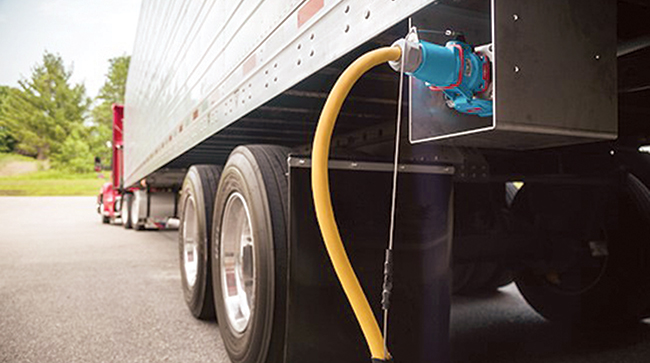
SafeConnect markets a six-pin plug and tension-release mechanism that instantly shuts down the control system in case of an accidental drive-off. (SafeConnect)
“One of the most common issues associated with legacy equipment is the accidental drive-off,” the company notes. “If a driver forgets to unplug before driving away, the plug and/or cord is ripped off the wall, creating a dangerous scenario for human contact with high-voltage live wires and the need for expensive equipment repairs.”
SafeConnect markets a six-pin plug and tension-release mechanism. In the event of an accidental drive-off, the tension release is designed to automatically eject the receptacle from the trailer, and the control system instantly shuts off all power in the plug, the cable and at the box, the company says.
KeHE Distributors, which is spec’ing the Carrier Vector 8600 MT (multi-temperature), is installing SafeConnect plug-in stations, which feature a six-pin plug.
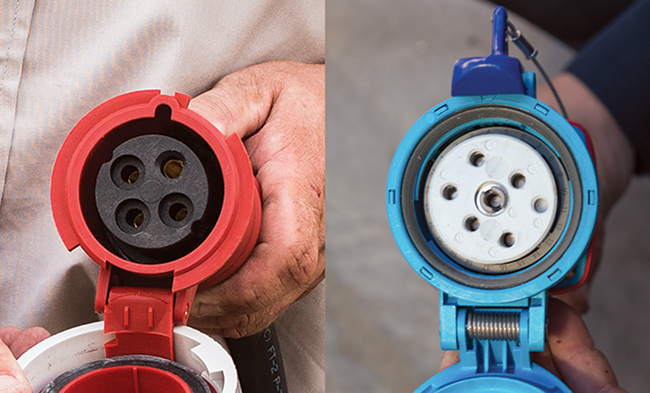
Historically, the standard for connecting electric standby equipment has been a four-pin twist lock plug with throw arm on/off controls. (SafeConnect)
“There is capital expense planning needed to purchase hybrid trailers and phase out old diesel-only TRU’s,” said Bobby Johns, vice president of business development for SafeConnect.
Limiting factors on all-electric, battery-powered refrigeration systems are weight and range, said Fox of Wabash National.
“Batteries don’t have the energy density of diesel,” he said.
Most all-electric truck and trailer solutions add weight.
“This means for the weight sensitive and long-range linehaul operations, diesel will remain the predominant solution,” he said. “This is specifically why all-electric systems are more commonly targeted for grocery and food delivery operations that have a more predictable, distribution center-to-store runs and can be plugged in at night to recharge.”
As solar, axle/wheel end electric regeneration and battery technology evolve, the ability of all-electric systems to work in longer linehaul operations will improve, Fox said.
Gordon Food Service partners with utilities “whenever and wherever we can,” said Derby, the fleet manager. The company also has invested in other forms of alternative energy.
“Our Michigan wind farm offsets 56% of the power requirements of our 24 North American distribution centers,” Derby said.
Want more news? Listen to today's daily briefing:
Subscribe: Apple Podcasts | Spotify | Amazon Alexa | Google Assistant | More


